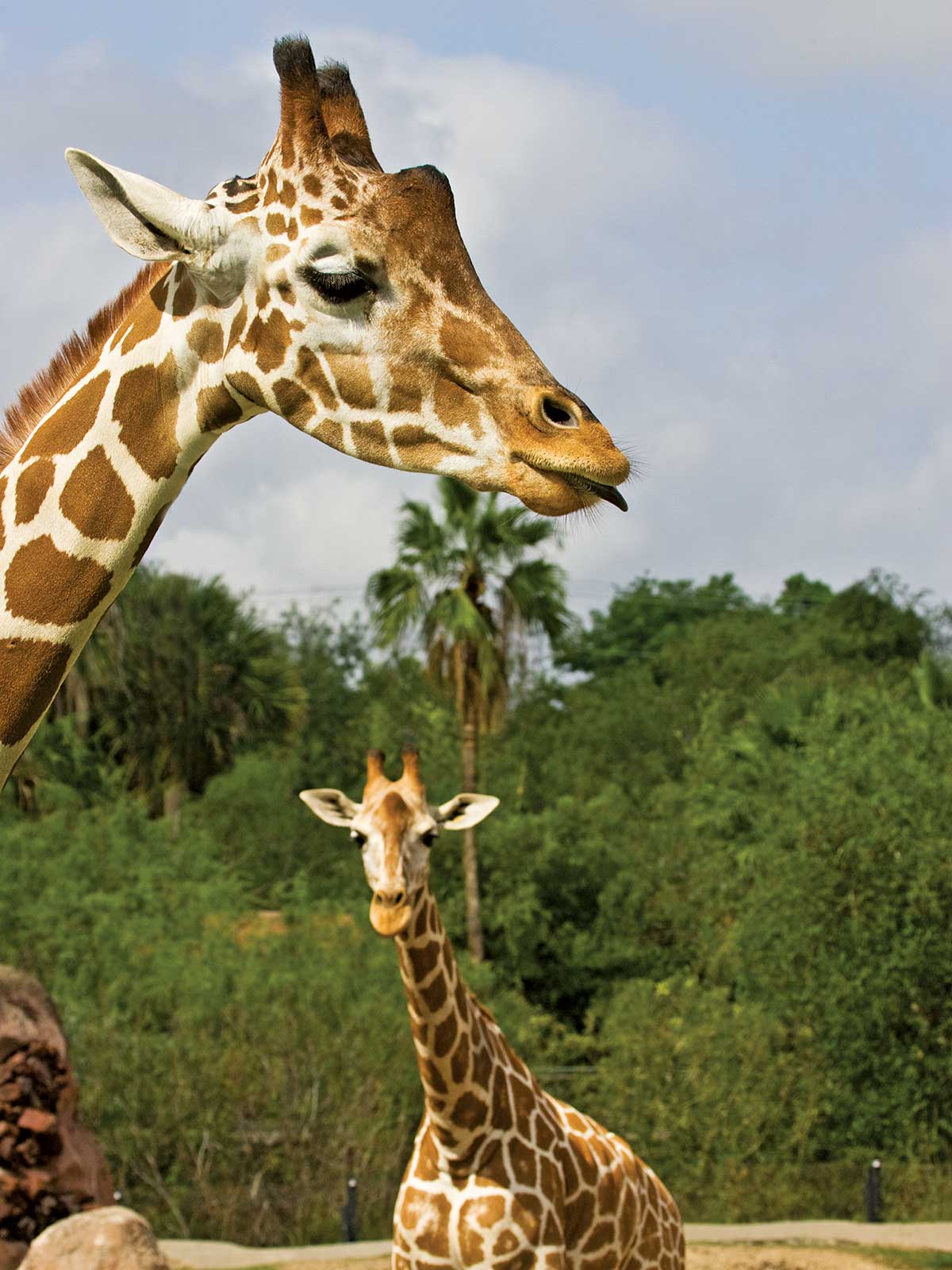At Brownsville’s Gladys Porter Zoo and Botanical Park, the subtropical climate of Texas’ southernmost city—minutes from South Padre Island and Mexico—creates an idyllic palm- and bougainvillea-filled setting for the zoo’s animals and their visitors. Rather than cages, Gladys Porter Zoo uses islands and moats to separate most animals from the public. The Old Town Resaca, an ancient Rio Grande overflow stream, loops through the zoo, where the sound of falling or trickling water provides a backdrop for the hooting of chimpanzees, the crazy laugh of kookaburras and the squealing of kids spotting tigers or seals.
Buy a bag of animal crackers and munch your way through this compact 27-acre garden with animals grouped by their home continent. Front and center in the lowland gorilla habitat, a gorilla mom resting in the shade cradles a napping baby in her arms, while juveniles romp around their green, one-eighth-acre island. The 15 gorillas here represent three generations, one of the most prolific populations in the United States.
“In the right climate, when they’re comfortable and eating well, animals will breed in spite of us,” says zoo facilities director Jerry Stones. Gladys Porter offers the ideal combination of factors for gorillas, flamingos, giraffes and Philippine crocodiles. Thriving populations have brought the zoo awards for its reproduction programs. But for the Jentink’s duiker, the last such antelope in captivity in the world, the story is sadder. There will be no progeny.
Year-round greenery drapes the private islands where gibbons and spider monkeys, lemurs and orangutans climb and swing on log structures. In contrast, the dry savanna enclosures of rhinos and the sleek massive guars, or wild Asian cattle, evoke images of long walks to water holes. Shaded benches along the broad walkways invite visitors to relax and observe the animals, although the zoo’s railings are a perfect height for comfortable leaning.
The atmosphere is pure peaceable kingdom. A huge Hong Kong orchid tree throws shade and orchid-like blooms into the lions’ grassy enclosure, where only glass separates you during truly close encounters. Tropical strangler fig vines creep up the reptile house. Red bougainvilleas tumble down the walls of the sun bear and spectacled bear enclosures. Everywhere, it’s pothos ivy gone wild, with leaves up to 20 inches long and twines running up trees and buildings.
Live kangaroos and wallabies compete for attention with a massive bronze statue of a saltwater crocodile, its snout gleaming from the touch of thousands of children who dare to stick their fingers in its mouth. A young camel suckles in the shade of its mother, and a dama gazelle wanders among the giraffes. Bongos, bonteboks and oryxes, all antelopes, graze.
For relief from the sun, duck inside a nocturnal exhibit. Large Egyptian fruit bats dart around their enclosure and then stack up like coats on a hook, attaching themselves to an air vent high on the wall. Another cool and dark facility brings you face to face with the herps: pythons, rattlesnakes, deadly mambas and yellow-banded poison frogs. Outside, an alligator snapping turtle poses underwater with its mouth open waiting for a fish to be attracted to its quivering “bait,” a tongue part that resembles a red, wriggling worm.
The zoo’s tropical lushness results from equal parts planning and chance. Migrating birds stop here on their flights north and drop seeds of southern plants. Much of the volunteer vegetation gets to stay, but the few poisonous invaders are uprooted immediately. “Some are so bad, so invasive, that it’s like having a coyote on the zoo grounds,” Stones says. Only a few blocks from Brownsville’s international bridges, the zoo also ends up with illegal tropical plants seized by customs officials.
Red banana trees grow freely, and the fruit is fed to the primates, “if we can beat the possums and birds to them,” Stones says. Yet tropical implies palms, and the zoo identifies many varieties: bottle, ponytail, foxtail, pindo and Texas’ only native palm, the Sabal. The botanical pride and joy is a limoncillo (esenbeckia runyonii), which is possibly Texas’ rarest tree. It’s the northernmost species of its type, a citrus associated with rain forests.
Native plants, like the limoncillo, make up about 50 percent of the zoo’s vegetation. That’s a result of the Rio Grande Valley’s last freeze some 20 years ago, when tropical plants’ tender leaves froze and temporarily deprived the zoo of its signature greenery of giant split-leaf philodendrons, hibiscus and birds of paradise. But freeze-hardy natives like anacua and huisache trees and lantana bushes not only add color and authenticity to the zoo, their abundant flowers and berries attract butterflies and birds. Flocks of wild Red-crowned Parrots and Green Parakeets descend to eat figs, nuts and tender flowers. Other local freeloaders—Black-bellied Whistling-Ducks and Great Blue Herons—roost and nest here, too.
“Butterflies, Bugs and Blooms,” the zoo’s newest exhibit, spotlights native plants like mesquite and ebony trees, cactus, and mistflower that provide food and shelter for a show-stopping array of local butterflies, plus tarantulas, scorpions and other critters. Some butterflies remain inside an enclosed, walk-through aviary that arches over the resaca.
The zoo’s Small World shelters small and young animals, from the cute golden-handed tamarin piggybacking a nearly invisible baby to screech owls and meerkats. The petting zoo, with its own hand-washing sink, lets kids cozy up to Nigerian dwarf goats, burros, hens and Merry, a baby camel whose heavy eyelashes seem caked with mascara.
A kiosk near the zoo entrance posts feeding times, a listing of animal babies and the amphitheater presentations that might feature an endangered species one day and skulls and skins the next. Sunday tram tours ($2) are available, as are ample benches and unobtrusive refreshment stands.
No matter the season, the animals of Gladys Porter Zoo and their visitors seem to relax amid the gorgeous tropical and native plants. Lions and tigers and Brasil trees, oh, my!
For more information, call (956) 546-7187 or go to www.gpz.org.


